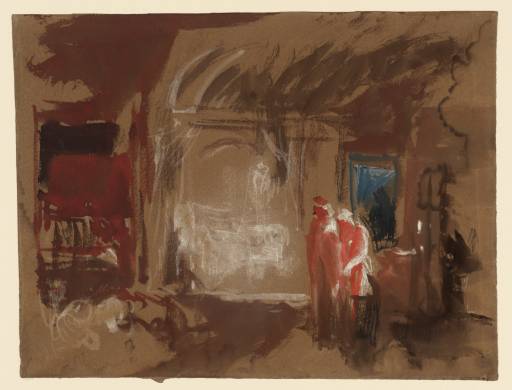Joseph Mallord William Turner A Couple in a Bedroom, ?Venice 1840
Joseph Mallord William Turner,
A Couple in a Bedroom, ?Venice
1840
Joseph Mallord William Turner 1775–1851
A Couple in a Bedroom, ?Venice 1840
D32228
Turner Bequest CCCXVIII 9
Turner Bequest CCCXVIII 9
Gouache and watercolour on grey-brown wove paper, 226 x 295 mm
Blind-stamped with Turner Bequest monogram towards bottom right
Stamped in black ‘CCCXVIII – 9’ bottom right
Blind-stamped with Turner Bequest monogram towards bottom right
Stamped in black ‘CCCXVIII – 9’ bottom right
Accepted by the nation as part of the Turner Bequest 1856
Exhibition history
1938
Four Screens, British Museum, London, September 1938 (no catalogue, but frame no.10).
1972
Director’s Study, British Museum, London, September 1972 (no catalogue).
References
1909
A.J. Finberg, A Complete Inventory of the Drawings of the Turner Bequest, London 1909, vol.II, p.1027, CCCXVIII 9, as ‘An Interior. [On back,] – “11.”’.
1930
A.J. Finberg, In Venice with Turner, London 1930, p.176, as ‘An Interior’, probably 1835.
1833
Lindsay Stainton, Turner’s Venice, London 1985, p.47 no.19, as ‘An interior’, ?1833, pl.19 (colour).
2003
Ian Warrell in Warrell, David Laven, Jan Morris and others, Turner and Venice, exhibition catalogue, Tate Britain, London 2003, p.259.
The Turner scholar C.F. Bell annotated Finberg’s noncommittal 1909 Inventory entry (‘An interior’), calling the subject ‘quite nondescript’,1 presumably in terms of its precise significance rather than its treatment, which is relatively clear. Finberg grouped the sheet with numerous identifiable Venice views on the grounds of the similarity of their technique and support (see the technical notes below), although it seems there is nothing unquestionably Venetian in the loosely rendered setting here, apparently a large bedroom with the glimmer of pale sheets within a curtained bed on the far side, with arcing white strokes in the shadows above suggesting a vaulted or decorated ceiling. The strong blue at the window evokes a night scene, perhaps with moonlight catching the outlines of the two standing figures; their summary combination of dusky pink and white suggests at least a degree of nudity, and the shorter figure appears to be a woman, perhaps in the act of letting a dark dress fall to the floor.
The work has previously attracted little comment. Lindsay Stainton has tentatively suggested that along with Tate D32233, D32237 and D32239 (Turner Bequest CCCXVIII 4, 18, 20), it may be among those showing ‘the interior of a theatre or recollections of a play in progress’.2 D32233 perhaps instead shows a Venetian workshop, and while D32237 does represent a theatre, D32239 is another ambiguous figure scene with partially dressed women, albeit perhaps with a distant echo of Shakespeare’s Romeo and Juliet, a source which Turner had previously and unconventionally linked with Venice. Tate D32236 (Turner Bequest CCCXVIII 17), a technically related bedroom scene, with a nude in a state of abandonment on a bed while at least one other figure stands by, has likewise been linked to Desdemona’s murder towards the end of Othello. If that were the case, it might argue for the present subject showing a preceding episode in Shakespeare’s drama (subtitled ‘the Moor of Venice’, albeit largely set in Cyprus), perhaps with Othello and Desdemona together.
In relation to the proposed theatrical connections, Stainton has noted how the ‘dark-toned paper and sweeping highlights of opaque bodycolour are perfectly suited to such subjects, which Turner clearly found exciting’.3 It might equally well be said that he found the erotic suggestiveness of such broad and indefinite forms stimulating, as discussed in the present author’s introduction to the ‘Erotica and Improvisations c.1834–6’ section of the present catalogue. The three small sketchbooks there feature vaguely defined forms emerging from watercolour washes, often coalescing as scenes in the dark confines of curtained beds; in relation to the present work see in particular a sequence in the Colour Studies (2) book (Tate D28874–D28880; Turner Bequest CCXCI c 1–6a).
Those small sketchbooks have sometimes been associated with Petworth House in Sussex, where Turner often stayed, producing a vivid series of gouache studies on blue paper in 1827 (mostly Tate; Turner Bequest CCXLIV) including numerous bedroom scenes, for example Tate D22679 and D22777 (CCXLIV 17, 115). Tate D36259 (Turner Bequest CCCLXIV 392), included in this Venice grouping but also previously also linked to Petworth, shows another shadowy interior with figures; see also D36089 (CCCLXIV 243). Turner depicted his own grand room in the Hotel Europa during his 1840 stay (Tate D32219; Turner Bequest CCCXVII 34).
Technical notes:
The prominent staining at the top right may be owing to the 1928 Tate Gallery flood.
This is one of numerous 1840 Venice-related works Ian Warrell has noted as being on ‘Grey-brown paper produced by an unknown maker (possibly ... a batch made at Fabriano [Italy])’;1 for numerous red-brown Fabriano sheets used for similar subjects, see for example under Tate D32224 (Turner Bequest CCCXVIII 5).
Warrell noted the grey-brown sheets as being torn into two formats: nine sheets of approximately 148 x 232 mm (Tate D32220, D32249–D32250, D32252–D32253, D32255–D32258; Turner Bequest CCCXVIII 1, CCCXIX 1, 2, 4, 5, 7–10), and seven of twice the size, at about 231 x 295 mm (Tate D32223, D32226, D32228–D32229, D32231, D32233, D32242; Turner Bequest CCCXVIII 4, 7, 9, 10, 12, 14, 23).
Verso:
Blank, with dark staining to the edges as on the recto; inscribed by Turner in ink ‘11’ bottom right, upside down (largely obscured by mount); inscribed in pencil ‘42’ above centre, ascending vertically; stamped in black with Turner Bequest monogram over ‘[...]’ bottom left; inscribed in pencil ‘D32228’ over ‘CCCXVIII [...]’ bottom right. For Turner’s ink numbering of many similar sheets, see the Introduction to the tour.
Matthew Imms
September 2018
How to cite
Matthew Imms, ‘A Couple in a Bedroom, ?Venice 1840 by Joseph Mallord William Turner’, catalogue entry, September 2018, in David Blayney Brown (ed.), J.M.W. Turner: Sketchbooks, Drawings and Watercolours, Tate Research Publication, December 2019, https://www

